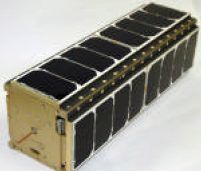
Home - Search - Browse - Alphabetic Index: 0- 1- 2- 3- 4- 5- 6- 7- 8- 9
A- B- C- D- E- F- G- H- I- J- K- L- M- N- O- P- Q- R- S- T- U- V- W- X- Y- Z
Genesat
 Genesat |
Status: Operational 2006.
A collaboration of NASA, industry, and local universities resulted in this fully-automated, miniaturized spaceflight system that provided life support, nutrient delivery, and performed assays to monitor genetic changes of E. coli bacteria in space conditions.
Genesat had the following characteristics:
Total Mass (Satellite + PPOD): 6.8 kg (4.6 + 2.2 kg)
Satellite Power (on-orbit average): 4 - 5 W
Satellite Volume: 3 "Cubes" (14" x 4.5" x 4.5") including antenna
Mission Duration: > 21 days (Experiment Duration ~ 100 hours)
Reentry: > 21 days (Experiment Duration ~ 100 hours)
The GeneSat-1 Team at Ames Research Center designed and developed the miniature biological stasis, growth, and analysis systems along with the necessary life support (culturing) capabilities to study gene and protein expression in model small/micro organisms. The system was fully self-contained and autonomous, and transmitted results to Earth, requiring no specimen return. The main project components were technology demonstration subsystems including quantitative fluorescent imagers, microfluidic networks, liquid arrays for the replicate study of multiple genetic constructs, and miniature environmental control and power management systems.
Future technology modules would enable small gene/protein array analyzers, imaging systems, and small spacecraft systems that could be carried as secondary payloads on planned missions, and specific reference-experiment protocols designed for the study of genetic changes arising from the unique space environment. Near-term plans included support for mammalian cell cultures, to allow characterization of gene/protein profiles of these highly relevant systems.
The use of low-cost, small-size, autonomous secondary payload concepts provided a means to study biological changes of fundamentally well understood microorganisms and mammalian cells at the gene/protein level. Such knowledge would be key to the development of effective countermeasures to the deleterious effects of long-duration space travel.
At the core of the GeneSat-1 demonstration platform was an integrated analytical fluidics card assembly. It included a media pump, valves, microchannels, filters, membranes, and wells to maintain the biological viability of various microorganisms. An integrated thermal control system maintained the biological specimens at physiological temperatures. The internal environment was monitored via a suite of sensors, and finally, expressions of genetic signals were detected by a miniaturized optical detection system.
Family: Biology. Country: USA. Launch Vehicles: Minotaur, Minotaur 1. Launch Sites: Wallops Island, Wallops Island LA0B. Agency: NASA Ames. Bibliography: 2.
Back to top of page
Home - Search - Browse - Alphabetic Index: 0- 1- 2- 3- 4- 5- 6- 7- 8- 9
A- B- C- D- E- F- G- H- I- J- K- L- M- N- O- P- Q- R- S- T- U- V- W- X- Y- Z
© 1997-2019 Mark Wade - Contact
© / Conditions for Use